Explore The Dynamic Culture Of Bali At Badung Market On Your 2026 Vacation In Bali
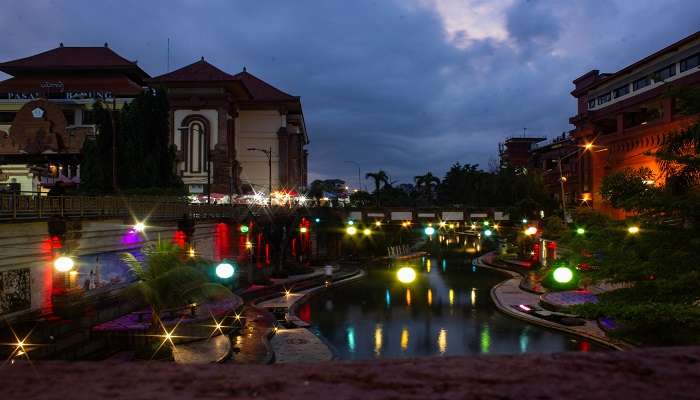
No trip to Bali would be complete without going shopping! If you want to achieve that, you must go to Badung Market! This largest traditional market is located in Denpasar, the most active city on the island. It offers a wide range of products, from essential commodities to the souvenirs of Bali. A four-story building awaits you to taste delicious food and buy food and clothes! Visit Badung Market for a shopping spree amidst coloured stalls containing local artistry products, fruits and spices. You’ll definitely enjoy exploring the market. Moreover, there are plenty of great tourist attractions nearby.
Places To Visit Near Badung Market
While the Badung Market is lively in itself, you can explore numerous other places to learn more about Bali’s history and culture. Here are a few of them.
1. Bali Provincial State Palace
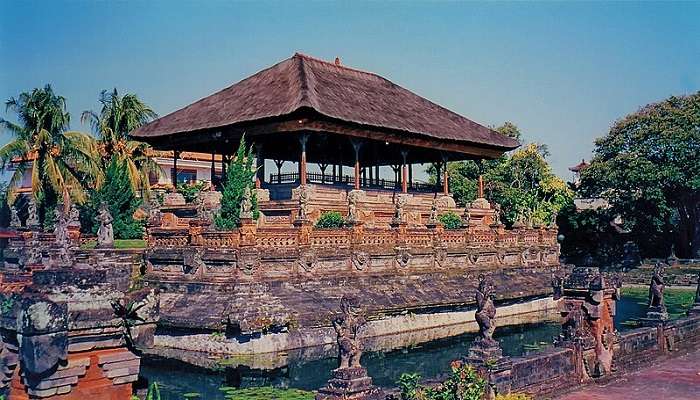
In Denpasar, Bali, the Bali Provincial State Palace, often called Puri Satria near Badung Market, is a significant historical and cultural site. The official residence of the Bali Governor, this ancient Balinese palace is an important venue for ceremonial and administrative events. Apart from this, one can enquire about Badung Market’s opening hours and can do shopping. Bali’s cultural diversity and architectural genius are embodied at Puri Satria. They include doorways, carvings, elaborate gateways, and exquisite gardens and pavilions representing traditional Balinese architecture. Some of the structural and ornamental aspects are Hinduistic in origin, and the building as a whole is built with much care to represent Balinese architectural principles.
The palace’s architectural structure and history interest most visitors. The palace compound has many pavilions and halls for formal occasions and celebrations. The elaborate carvings that are found on every structure in the royal complex show the skills of Balinese craftsmen. The greenery around the palace adds to its royal and serene atmosphere and is an oasis amidst the city’s concrete jungle. The palace is an important cultural landmark despite being mainly a governmental building and might not always be open for touring. It is advantageous to include it in the list of tourist attractions to visit in Denpasar because of its proximity to other important cultural landmarks such as Pura Jagatnatha, and Bali Museum.
Distance: Approximately 2.7 kilometres
Timings: 8:00 AM – 5:00 PM
Must Read: Best Restaurants In Bali
2. Pasar Kumbasari And Pasar Badung
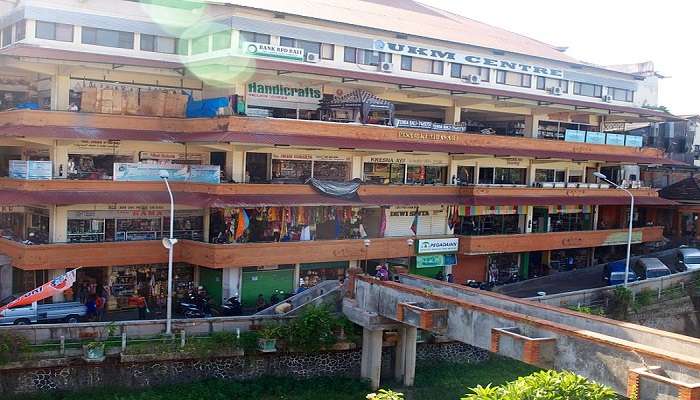
Two of Denpasar, Bali’s most well-known traditional marketplaces, Pasar Kumbasari and Pasar Badung, provide lively, immersive glimpses into the daily lives and customs of the locals. Situated in the heart of Denpasar, next to the Badung River, is the biggest traditional market, Pasar Badung traditional market in Bali. It is always busy, running from early in the morning till late at night. The market is a multi-level building where a wide range of products are sold by merchants. Fresh produce, which includes fruits, vegetables, meats, spices, and other items, usually occupies the main floor and offers a visual and olfactory feast of hues and scents.
Stalls offering textiles, handicrafts, traditional Balinese apparel, and home goods are located on the upper floors of Badung local market. Pasar Badung is a great area to watch Balinese daily life and culture because it’s not all about shopping in Badung Market but also a hub for the community. Pasar Kumbasari, next to Pasar Badung, enhances what Pasar Badung offers by emphasising arts, crafts, and traditional Balinese trinkets. Tourists searching for distinctive and genuine souvenirs to bring home are especially drawn to this market.
Distance: Approximately 0.3 to 0.6 miles
Timings: 8:00 AM – 5:00 PM
3. Pura Maospahit
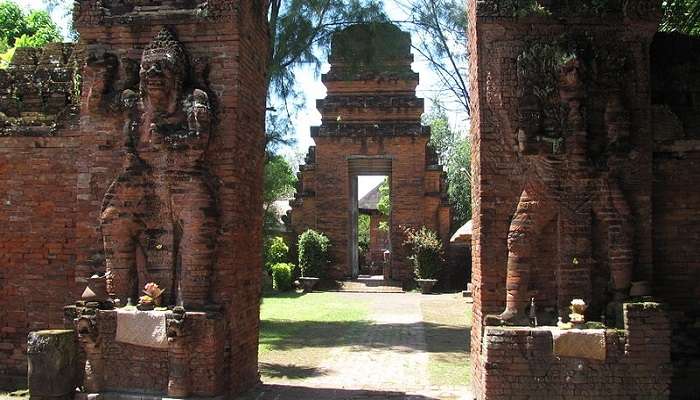
Situated in the centre of Denpasar, Bali, Pura Maospahit is one of the oldest and most important temples in the island’s history. This Hindu temple is an important component of Bali’s rich religious and cultural legacy, having been around since the fourteenth century. It is thought to have been constructed during the Majapahit Empire, which profoundly impacted Balinese architecture, religion, and culture. The temple is well known for its distinct architectural design that sets it apart from many other Bali temples. The use of terracotta and red bricks, two characteristic Majapahit architectural features, is displayed in Pura Maospahit. The ancient Javanese influences that came to Bali with the expansion of the Majapahit Empire are reflected in these materials and the temple’s design.
Pura Maospahit is an important spiritual hub for the neighbourhood. It draws devotees who come to pray and participate in customary practices during the year’s many religious festivities and rites. The temple complex has multiple courtyards, each with a different meaning and decorated with shrines and holy sculptures. A peaceful and contemplative experience, Pura Maospahit offers a window into Bali’s old past and spiritual customs.
Distance: Approximately 2.4 kilometres
Timings: 6:00 AM – 6:00 PM
Suggested Read: Famous Villages In Bali
4. Sakenan Temple
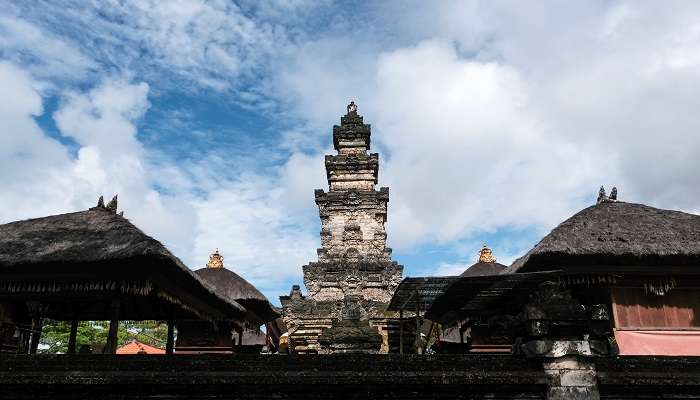
Located on Serangan Island, south of Denpasar, Bali, Sakenan Temple, also called Pura Sakenan in the local dialect, is a highly respected Hindu temple. The sea goddess Dewa Baruna is honoured in this temple, which has immense cultural and spiritual value for the Balinese people. People also love to go to Badung’s local market. Sakenan Temple is one of Bali’s oldest temples, having been around since the 10th century. Mpu Kuturan, a well-known Hindu priest who was instrumental in the growth of Hinduism on the island, founded it. Originally, the temple complex was used by priests seeking spiritual inspiration and seclusion.
Sakenan Temple is extremely well-known for its yearly rituals, especially during the Kuningan festival. Kuningan is a celebration that culminates the 10-day Galungan festival and honours the triumph of good over evil, or dharma over adharma. Thousands of devotees swarm the temple at this time to offer prayers and participate in customary rites. These spiritual pursuits are enhanced by the tranquil and gorgeous setting of the temple beside the sea. Sakenan Temple’s architecture, which features finely carved stone shrines and gateways, is reminiscent of traditional Balinese architecture.
Distance: Approximately 10 kilometres
Timings: 24 hours open
5. Bali Orchid Garden
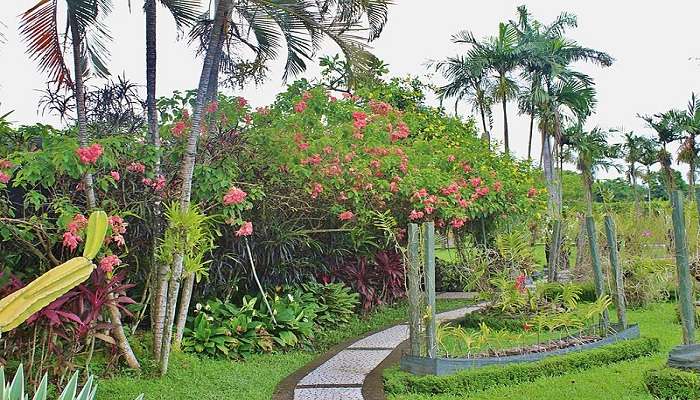
The Bali Orchid Garden provides tourists with an exotic scope to admire different types of flowers, especially the orchids and other tropical flowers. Near the Badung traditional market is the two hectares of luxuriant garden that provide a tranquil haven for horticulturalists and nature lovers. The 1999-founded Bali Orchid Garden aims to conserve and advance the production of orchids, a plant of significant cultural and horticultural value in Bali. Many types and varieties of orchids, including some of the rarest types of orchids, are grown in the garden. The spectacular flowers in bright colours and geometric patterns amaze the guests on detailed planted backgrounds.
The breaks that divide the several regions of the tropical garden—each of which has a special reference to the flora—are intended to give the impression of being enclosed by the plants. Other tropical plants grown in the garden include Heliconias, Gingers, and Anthuriums, in addition to the orchids, so the garden seems to be very brightly and diversely planted.
Distance: Approximately 3 kilometres
Timings: None
Suggested Read: Blanco Renaissance Museum
6. Bajra Sandhi Monument
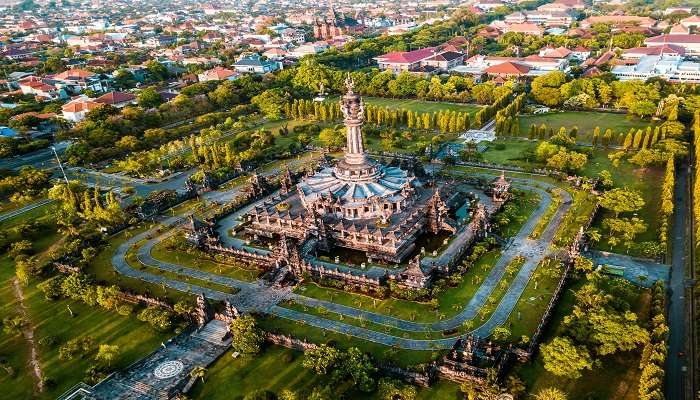
Another major landmark of Bali is the Bajra Sandhi Monument, symbolising the Balinese resilience, rich heritage, and their struggle for freedom. This beautiful monument is situated in Renon Square, Denpasar, the capital city of Bali, and has been built to symbolise the struggles that the people of Bali have faced in the past. The Bajra Sandhi Monument was constructed in 1987 to honour the Balinese population’s struggle for freedom and against colonisation. It is called Bajra Sandhi, which means ‘the bell of victory’ in Sanskrit because the Balinese spirit had triumphed over adversity. The tall structure of the monument in the form of a royal bell and numerous gardens and lakes around it are patented Balinese architecture.
Bajra Sandhi Monument has three floors, each of which is devoted to the different aspects of Balinese culture and history. These levels are also open to visitors. On the ground floor, there is a large diorama that describes the island’s history, from prehistoric times to the independence movement. It captures the heroic stories of the island as well as its cultural history through carvings and statues. The exhibition galleries on the higher levels enable the visitors to gain more insight into Balinese history and traditions with the help of antique items. The monument’s expansive observation deck offers calm surroundings and breathtaking views over Denpasar city, making it an ideal place for introspection and meditation.
Distance: Approximately 3 kilometres
Timings: 8:30 AM – 5:00 PM
Further Read: Things Not To Do In Bali
Not only a trading centre, Badung Market is a rainbow of colours, fragrances, and traditions embody Bali’s essence. Go for a trip to Bali and visit the Badung Market a symbol of the Balinese heritage and enterprise selling locally crafted items and many fresh fruits in the crowded alleys.
For our editorial codes of conduct and copyright disclaimer, please click here.
Cover Image Source: Shutterstock
Frequently Asked Questions About Badung Market
Are there any travel advice or tips for Badung Market?
As the market might get too congested and the climate is hot, wearing comfortable clothes and shoes is advisable. It is also advisable to have money because not all merchants accept credit cards. So, do not be afraid to haggle and explore all the marketplace sections.
When is the best time to visit the Badung Market?
The most bustling time of the morning is when sellers are preparing their stalls and people are coming to buy vegetables and other agricultural products. However, the market is always open during the day, and therefore, the public can visit at any time of the day and feel the energy of the marketplace. You do not need to worry about the Badung Market opening hours as it is open 24x7.
Bargaining is a culture in Badung Market. Is it normal to do so?
However, bargaining is evident at Badung Market, especially for goods with fluctuating price levels such as textile materials and trinkets. Customers tend to negotiate with the seller to find a suitable price.
Are there many tourists visiting Badung Market?
While most of its customers are residents, tourists who want to taste authentic Balinese cuisine and experience the local culture also visit the Badung Market. Most of the merchants may know some basic English and would expect tourists to engage in a conversation with them.
What is available in the Badung Market in Bali?
At Badung Market in Bali, a wide range of products are available for purchase, such as fresh produce, meats, fresh fruits, spices, textiles, apparel, accessories, and souvenirs. In addition, the market is well-known for its lively ambience and regional street food vendors. You will surely enjoy shopping in Badung Market.
People Also Read:
Port Louis Market Ubud Art Market Bali Damnoen Saduak Floating Market
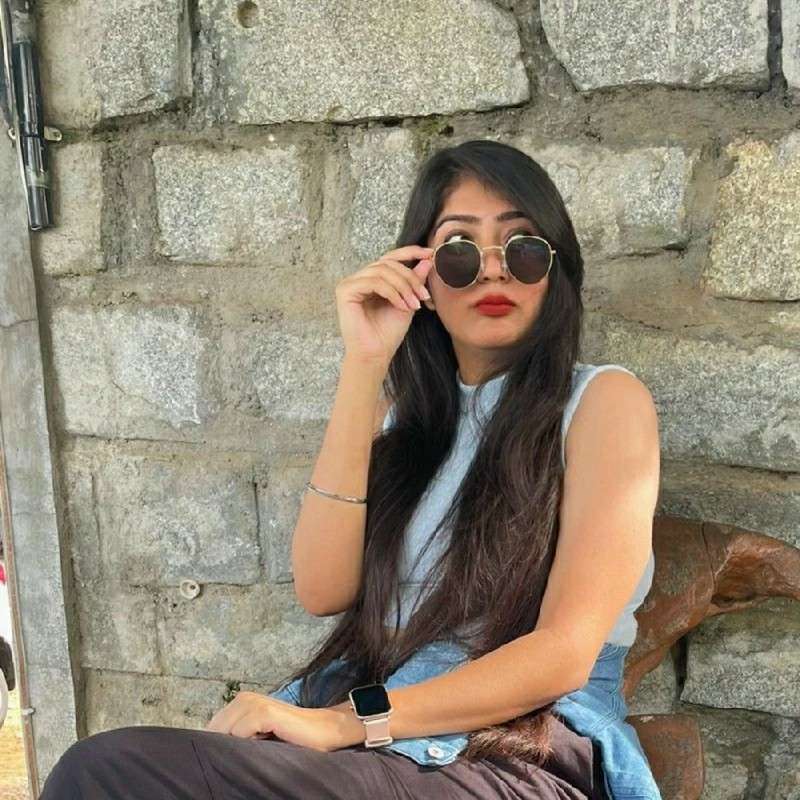
Experience the world through captivating stories of adventure and travel. As a senior content writer, I bring my passion for exploration to life, crafting tales that take you on a journey. With my words, you’ll feel the thrill of discovery and the joy of experiencing new cultures. Let me turn your imagination into a reality with stories that inspire you to explore and embrace the world.











